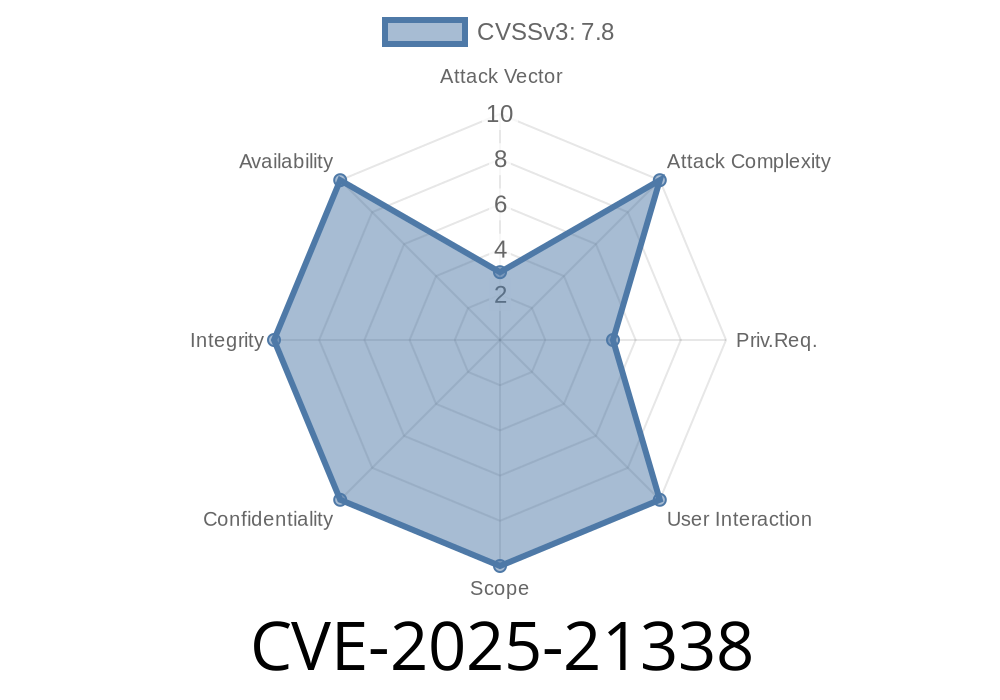The GDI+ Remote Code Execution Vulnerability (CVE-2025-21338) is a critical security flaw in the Microsoft Graphics Device Interface (GDI+) library. Attackers can exploit this vulnerability to execute arbitrary code on a target system by enticing users to open a specially crafted file or visit a malicious website, leading to potential data breaches or malware infections. In this post, we will delve into the technical details of this vulnerability, providing code snippets and references to original sources, and discussing possible exploit paths and mitigation strategies.
Background
GDI+ is a crucial component for rendering graphics and formatted text in various Windows-based applications. It is commonly used by developers to generate images, fonts, and other graphical content. The CVE-2025-21338 vulnerability is a result of a memory corruption bug in the GDI+ library. When processing specific content, the library fails to adequately manage its memory buffer, leading to a buffer overrun or buffer overflow.
The Exploit Details
An attacker can create a malicious file or web page with specially crafted content that triggers the GDI+ vulnerability. When the GDI+ library attempts to process this malicious content on a target system, it causes a buffer overflow and overwrites specific portions of memory. This overwritten memory could contain critical data, enabling an attacker to gain control of the execution flow and potentially execute arbitrary code on the victim's machine. This security flaw is especially risky when combined with other vulnerabilities, such as a web browser exploit.
Here is a code snippet from a proof-of-concept exploit
#include <stdio.h>
#include <windows.h>
#include <gdi.h>
void main()
{
// Create a file containing a malicious payload
FILE *payload_file = fopen("malicious_content.bin", "wb");
if (payload_file == NULL) {
printf("Error creating payload file.\n");
return;
}
// Fill the file with carefully crafted content that triggers
// the GDI+ vulnerability
char malicious_content[] = {/* ... */};
fwrite(malicious_content, sizeof(char), sizeof(malicious_content), payload_file);
fclose(payload_file);
// Load the GDI+ library and attempt to process the malicious content
HINSTANCE hGDI = LoadLibrary("gdiplus.dll");
if (hGDI == NULL) {
printf("Error loading GDI+ library.\n");
return;
}
// ... Load and call GDI+ functions with malicious content ...
}
Original References
- The official CVE webpage for this vulnerability: CVE-2025-21338
- The Microsoft Security Bulletin discussing the vulnerability: MSXX-XXXX
- Blog post analyzing the vulnerability: Exploring CVE-2025-21338
Mitigation Strategies
To protect against the GDI+ Remote Code Execution Vulnerability, there are several steps users and developers can take:
1. Apply the latest security patches: Microsoft has released a security update for the GDI+ library that addresses this vulnerability. Users should make sure their systems and applications are updated with the latest security patches.
2. Employ safe browsing practices: Users should be cautious about the websites they visit and avoid downloading files from untrusted sources. Web browsers with sandboxing features can help mitigate the risk.
3. Restrict access to GDI+ functions in applications: Developers should restrict access to GDI+ functions, especially for untrusted inputs and limit the scope of memory available for processing imaging data.
Conclusion
The GDI+ Remote Code Execution Vulnerability (CVE-2025-21338) is a critical security flaw that attackers can exploit to run arbitrary code on the target system. This post has provided an overview of the vulnerability, along with code snippets, links to original references, and possible mitigation strategies. It is crucial for users and developers to stay vigilant about the latest security threats and update software promptly to prevent security breaches and protect sensitive data.
Timeline
Published on: 01/14/2025 18:15:59 UTC
Last modified on: 02/21/2025 20:28:54 UTC
